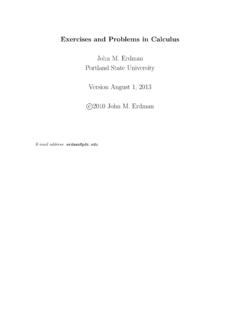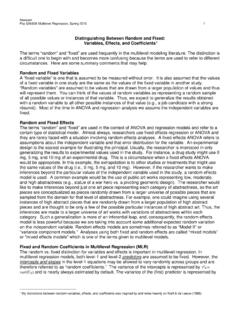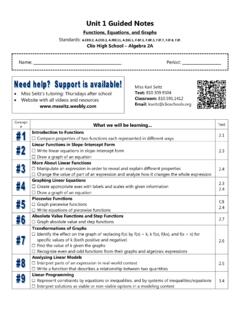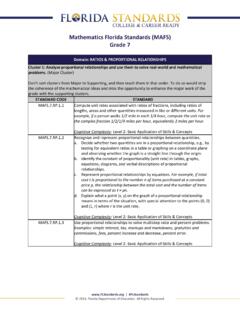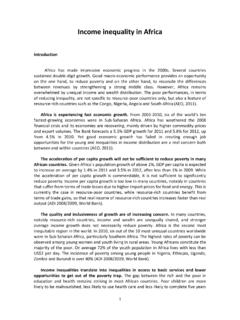Transcription of John M. Erdman Portland State University Version August 1 ...
1 Exercises and Problems in CalculusJohn M. ErdmanPortland State UniversityVersion August 1, 2013c 2010 John M. ErdmanE-mail 1. PRELIMINARY MATERIAL1 Chapter 1. inequalities AND absolute Answers to Odd-Numbered Exercises6 Chapter 2. LINES IN THE Answers to Odd-Numbered Exercises10 Chapter 3. Answers to Odd-Numbered Exercises17 Part 2. LIMITS AND CONTINUITY19 Chapter 4. Answers to Odd-Numbered Exercises25 Chapter 5. Answers to Odd-Numbered Exercises30 Part 3. DIFFERENTIATION OF FUNCTIONS OF A SINGLE VARIABLE31 Chapter 6. DEFINITION OF THE Answers to Odd-Numbered Exercises37 Chapter 7. TECHNIQUES OF Answers to Odd-Numbered Exercises47 Chapter 8. THE MEAN value Answers to Odd-Numbered Exercises52 Chapter 9.
2 L H OPITAL S Answers to Odd-Numbered Exercises57 Chapter 10. MONOTONICITY AND Answers to Odd-Numbered Exercises66 Chapter 11. INVERSE Answers to Odd-Numbered Exercises74 Chapter 12. APPLICATIONS OF THE Answers to Odd-Numbered Exercises84 Part 4. INTEGRATION OF FUNCTIONS OF A SINGLE VARIABLE87 Chapter 13. THE RIEMANN Answers to Odd-Numbered Exercises95 Chapter 14. THE FUNDAMENTAL THEOREM OF Answers to Odd-Numbered Exercises105 Chapter 15. TECHNIQUES OF Answers to Odd-Numbered Exercises118 CONTENTSvChapter 16. APPLICATIONS OF THE Answers to Odd-Numbered Exercises130 Part 5. SEQUENCES AND SERIES131 Chapter 17. APPROXIMATION BY Answers to Odd-Numbered Exercises137 Chapter 18.
3 SEQUENCES OF real Answers to Odd-Numbered Exercises144 Chapter 19. INFINITE Answers to Odd-Numbered Exercises149 Chapter 20. CONVERGENCE TESTS FOR Answers to Odd-Numbered Exercises156 Chapter 21. POWER Answers to Odd-Numbered Exercises166 Part 6. SCALAR FIELDS AND VECTOR FIELDS169 Chapter 22. VECTOR AND METRIC PROPERTIES Answers to Odd-Numbered Exercises179 Chapter 23. LIMITS OF SCALAR Answers to Odd-Numbered Exercises185 Part 7. DIFFERENTIATION OF FUNCTIONS OF SEVERAL VARIABLES187viCONTENTSC hapter 24. PARTIAL Answers to Odd-Numbered Exercises193 Chapter 25. GRADIENTS OF SCALAR FIELDS AND TANGENT Answers to Odd-Numbered Exercises201 Chapter 26. MATRICES AND Answers to Odd-Numbered Exercises213 Chapter 27.
4 LINEAR Answers to Odd-Numbered Exercises221 Chapter 28. DEFINITION OF Answers to Odd-Numbered Exercises227 Chapter 29. DIFFERENTIATION OF FUNCTIONS OF SEVERAL Answers to Odd-Numbered Exercises237 Chapter 30. MORE APPLICATIONS OF THE Answers to Odd-Numbered Exercises244 Part 8. PARAMETRIZED CURVES245 Chapter 31. PARAMETRIZED Answers to Odd-Numbered Exercises256 Chapter 32. ACCELERATION AND Answers to Odd-Numbered Exercises265 Part 9. MULTIPLE INTEGRALS267 Chapter 33. DOUBLE Answers to Odd-Numbered Exercises275 Chapter 34. Answers to Odd-Numbered Exercises281 Chapter 35. SURFACE Answers to Odd-Numbered Exercises287 Chapter 36. TRIPLE Answers to Odd-Numbered Exercises293 Chapter 37.
5 CHANGE OF VARIABLES IN AN Answers to Odd-Numbered Exercises299 Chapter 38. VECTOR Answers to Odd-Numbered Exercises304 Part 10. THE CALCULUS OF DIFFERENTIAL FORMS305 Chapter 39. DIFFERENTIAL Answers to Odd-Numbered Exercises311 Chapter 40. THE EXTERIOR DIFFERENTIAL Answers to Odd-Numbered Exercises317 Chapter 41. THE HODGE STAR Answers to Odd-Numbered Exercises322 Chapter 42. CLOSED AND EXACT DIFFERENTIAL Answers to Odd-Numbered Exercises326 Part 11. THE FUNDAMENTAL THEOREM OF CALCULUS327 Chapter 43. MANIFOLDS AND Background The Language of Manifolds329 Oriented points330 Oriented curves330 Oriented surfaces330 Oriented Answers to Odd-Numbered Exercises335 Chapter 44. LINE Answers to Odd-Numbered Exercises343 Chapter 45.
6 SURFACE Answers to Odd-Numbered Exercises349 Chapter 46. STOKES Answers to Odd-Numbered Exercises358 Bibliography359 Index361 PrefaceThis is a set ofexercisesandproblemsfor a (more or less) standard beginning calculus a fair number of theexercisesinvolve only routine computations, many of theexercisesandmost of theproblemsare meant to illuminate points that in my experience students have all of theexerciseshave fill-in-the-blank type answers. Often anexercisewill endwith something like, .. so the answer isa 3 + bwherea=andb=. Oneadvantage of this type of answer is that it makes it possible to provide students with feedback on asubstantial number of homework exercises without a huge investment of time. More importantly,it gives students a way of checking their work without giving them the answers.
7 When a studentworks through theexerciseand comes up with an answer that doesn t look anything likea 3 + b,he/she has been given an obvious invitation to check his/her major drawback of this type of answer is that it does nothing to promote good communi-cation skills, a matter which in my opinion is of great importance even in beginning courses. Thatis what theproblemsare for. They require logically thought through, clearly organized, and clearlywritten up reports. In my own classes I usually assignproblemsfor group work outside of serves the dual purposes of reducing the burden of grading and getting students involved inthe material through discussion and collaborative collection is divided into parts and chapters roughly by topic. Many chapters begin witha background section. This is most emphaticallynotintended to serve as an exposition of therelevant material.
8 It is designed only to fix notation, definitions, and conventions (which varywidely from text to text) and to clarify what topics one should have studied before tackling theexercisesandproblemsthat flood of elementary calculus texts published in the past half century shows, if nothing else,that the topics discussed in a beginning calculus course can be covered in virtually any order. Thedivisions into chapters in these notes, the order of the chapters, and the order of items within achapter is in no way intended to reflect opinions I have about the way in which (or even if) calculusshouldbe taught. For the convenience of those who might wish to make use of these notes I havesimply chosen what seems to me one fairly common ordering of topics. Neither theexercisesnor theproblemsare ordered by difficulty. Utterly trivial problems sit alongside ones requiring chapter ends with a list of the solutions to all the great majority of the applications that appear here, as in most calculus texts, are bestregarded as jests whose purpose is to demonstrate in the very simplest ways some connectionsbetween physical quantities (area of a field, volume of a silo, speed of a train,etc.)
9 And themathematics one is learning. It doesnotmake these real world problems. No one seriouslyimagines that some Farmer Jones is really interested in maximizing the area of his necessarilyrectangular stream-side pasture with a fixed amount of fencing, or that your friend Sally justhappens to notice that the train passing her is moving at mph. To my mind genuinelyinteresting real world problems require, in general, way too much background to fit comfortablyinto an already overstuffed calculus course. You will find in this collection just a very few seriousapplications, problem 15 in Chapter 29, for example, where the background is either minimal orlargely irrelevant to the solution of the make no claims of originality. While I have dreamed up many of the items included here,there are many others which are standard calculus exercises that can be traced back, in one form oranother, through generations of calculus texts, making any serious attempt at proper attributionquite futile.
10 If anyone feels slighted, please contact will surely be errors. I will be delighted to receive corrections, suggestions, or have placed the the LATEX source files on my web page so that anyone who wishes can downloadthe material, edit it, add to it, and use it for any noncommercial 1 PRELIMINARY MATERIALCHAPTER 1 inequalities AND absolute BackgroundTopics: inequalities , absolute two real numbers thedistancebetweenxandais|x a|. Formost purposes in calculus it is better to think of an inequality like|x 5|<2 geometrically ratherthen algebraically. That is, think The numberxis within 2 units of 5, rather than The absolutevalue ofxminus 5 is strictly less than 2. The first formulation makes it clear thatxis in the openinterval (3,7). a real number. Aneighborhoodofais an open interval (c,d)inRwhich containsa. An open interval (a ,a+ ) which is centered atais asymmetricneighborhood(or a -neighborhood) (orpunctured)neighborhoodof a pointa Ris an openinterval aroundafrom whichahas been deleted.
